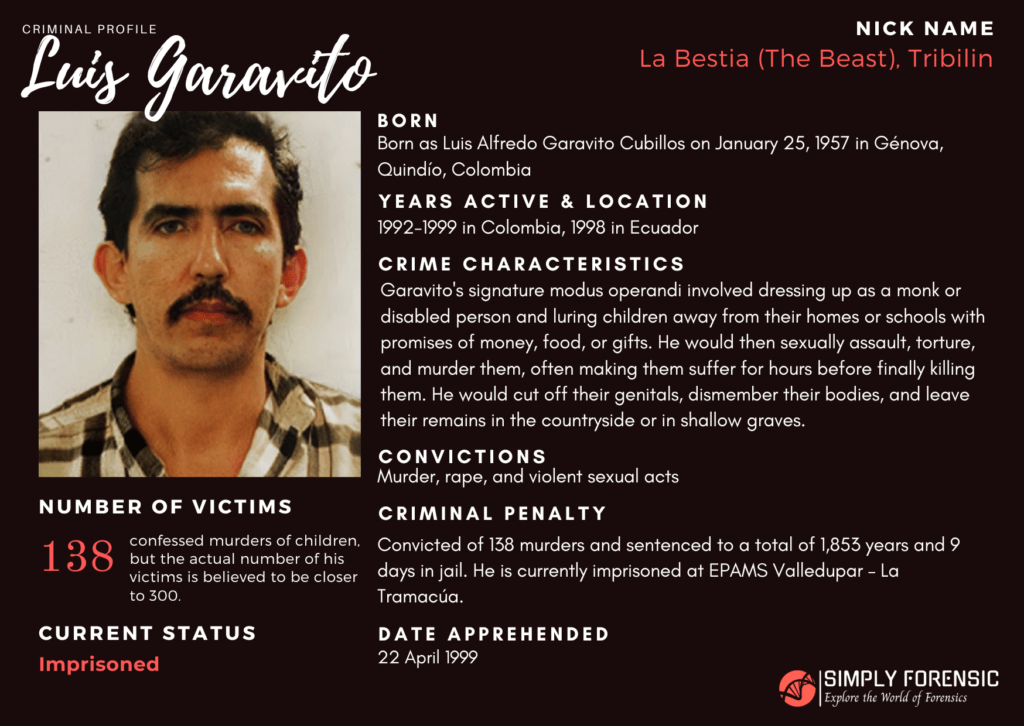Luis Garavito, known as “La Bestia” or “The Beast,” was a Colombian serial killer, pedophile, and necrophile whose seven-year reign of terror from 1992 to 1999 left a trail of horror across the nation. Convicted of murdering 138 boys, he confessed to killing over 190, making him one of the most prolific serial killers in history. His crimes exposed deep societal fractures and forced a reckoning within Colombia’s justice system.
- Early Life and Path to Darkness
- The Reign of “La Bestia”
- Modus Operandi: Deception and Brutality
- Investigation and Capture
- Critical Witness Accounts and the Capture of Luis Garavito
- A Pivotal Witness Emerges
- The Final Misstep
- The Arrest and Forensic Breakthrough
- The Interrogation and Confession
- Justice, Aftermath, and Legacy
- Legacy of Evil: Transforming Colombia’s Criminal Justice System
- Conclusion:
Police caught him in April 1999, revealing the true horror of his crimes. Garavito confessed to killing 140 children after his arrest on attempted rape charges, though investigators believe the actual number of victims runs higher. He ended up being sentenced to 1,853 years and 9 days in prison, where he stayed until cancer took his life in October 2023 at age 66.
This article delves into the dark life of Luis Garavito, exploring his troubled childhood, the methods behind his horrific crimes, the investigation that finally brought him down, and the lasting legacy he left on a terrified nation.

Early Life and Path to Darkness
“Luis Garavito was born on January 25, 1957 in Genova, Colombia. His mother was a drug-addicted prostitute and his father was an alcoholic who abused both him and his mother.” — Anthony Promo, Student researcher at Penn State University
Troubled childhood in Génova
Born on January 25, 1957, in Génova, Quindío, Luis Alfredo Garavito Cubillos was the eldest of seven siblings in a deeply dysfunctional household. His early years were defined by severe poverty, neglect, and violence. His father, known as a “womanizer,” was an abusive alcoholic, and his mother was often unable to provide nurturing care, leaving Garavito and his siblings in a constant state of fear.
The ongoing armed conflict in Colombia forced his family to relocate frequently. His education at Simón Bolívar School was cut short in 1968 when his father withdrew him from the fifth grade to help with the family’s financial struggles. Shortly after, at age 12, Garavito was sexually abused by a local drugstore owner and neighbor during his father’s visits to the store for Garavito’s vaccinations. This traumatic period marked a significant turn, as he reportedly began killing and dissecting animals, an early indicator of his psychological decline.
Signs of disturbing behavior
Several incidents revealed Garavito’s psychological decline:
- He started to kill and analyze birds in 1969 after a neighbor sexually abused him
- He touched his younger siblings inappropriately
- His aggressive sexual behavior toward local women emerged by 1972
- Young boys became his assault targets, which led to multiple evictions
Descent into Addiction and Violence
As a teenager, at the age of 16, Garavito left home and drifted between odd jobs, descending further into alcoholism. While he could be kind when sober, his drunken states unleashed violent and controlling outbursts. His mental health deteriorated, marked by depression, paranoia, and suicidal thoughts, leading to a five-year period of psychiatric care after a suicide attempt.
By 1978, his alcoholism was so severe that he began attending Alcoholics Anonymous. However, his erratic behavior and addiction eventually alienated him from everyone, including his closest sister, Esther. At the same time, Colombia’s civil war had left countless children orphaned and homeless, creating a vulnerable population that predators like Garavito could easily exploit.
The Reign of “La Bestia”
In the 1980s, Garavito began carrying items like razors and lighters, foreshadowing the torture-based assaults he would later commit on minors aged 6 to 16. He started keeping a blue notebook with his victims’ names and engaged in peculiar rituals. Before his murder spree began in October 1992, it’s estimated he had already sexually assaulted at least 200 minors.
Reign of Terror Begins
The transformation into “La Bestia” reached its terrifying peak on October 4, 1992, when he murdered 13-year-old Juan Carlos in Jamundí. Garavito bought a butcher’s knife and synthetic rope after drinking alcohol. He lured the boy with promises of money. The victim’s body had signs of brutal torture, missing front teeth, and severe injuries. Garavito claimed that a “strange force” overtook him near a moonlit river and triggered memories of his childhood after this ordeal. The victim’s body had severe mutilations, knocked-out front teeth, and critical injuries. Garavito killed again just days later in Trujillo, where he took the life of 12-year-old Jhon Alexander Peñaranda.
The Hunting Grounds
His operations were not confined to one region; his crimes spread through at least 11 of Colombia’s 32 departments. The western state of Risaralda, with its capital Pereira, became a major hub for his activities—41 bodies were discovered there—while the neighboring Valle del Cauca accounted for another 27 victims. Garavito’s reach even extended beyond Colombian borders into Ecuador and Venezuela, where he selected secluded areas near railroad tracks or in remote jungles to reduce the risk of evidence
Modus Operandi: Deception and Brutality
Garavito’s method was a chilling blend of calculated deception and sadistic violence. He refined his approach over the years into a distinct and terrifying pattern.
- Master of Disguise: Garavito’s ability to blend into the surroundings was a key factor in his reign of terror. He frequently adopted multiple personas to evade detection, posing as a monk (earning him the nickname “El Cura”), an elderly man, a street vendor, or even a representative of fictitious educational foundations. These disguises allowed him to gain the trust of his victims and their communities.
- Victim Selection: He specifically targeted boys between the ages of 8 and 16, primarily from impoverished backgrounds—homeless, orphaned, or working-class children. He often chose victims with lighter features — typically selecting those with blondish skin and blue or green eyes — who were often found in areas with a high concentration of Spanish-descended populations, approaching them in public places during the day.
- Garavito mainly targeted boys, though he was also known to molest and kill female victims. Besides the initial 172 murder charges, he admitted to 28 more killings in 2003, five of which involved adults. The adult victims were likely murdered to eliminate possible witnesses rather than satisfy personal desires.
- Luring and Isolation: Offering money, food, or drinks, he would lead the children on long walks to remote, secluded areas, tiring them out before attacking. He would then attack the helpless children, tying up their wrists and submitting them to horrific torture. His monstrous acts earned him the ominous nickname ‘The Beast.’
- Torture and Murder: Once isolated, he would tie his victims with nylon rope, torture, and mutilate them. His monstrous acts, often fueled by alcohol, culminated in him slitting their throats or beheading them. He claimed to have made a pact with the devil, viewing the murders as satanic rituals. He was also known to have committed acts of necrophiliaNecrophilia is a sexual attraction or an act involving corpses. Read Full Definition.
His hunting grounds spread across at least 11 of Colombia’s 32 departments, with major hubs in Risaralda and Valle del Cauca. The authorities noticed similar disappearance patterns in Pereira, Armenia, and Tunja. He even extended his crimes into Ecuador.
Investigation and Capture
Colombia’s “Disposable” Children
For years, Garavito’s crimes went unnoticed. His victims were largely “desechables” (disposables)—children from the margins of society whose disappearances were rarely reported or investigated. With law enforcement focused on drug cartels and guerrilla warfare, the vanishing of poor children did not trigger a major response. This social invisibility, born from inequality and civil conflict, allowed “La Bestia” to kill without consequence.
The Grim Discovery and Investigation Challenges
The hunt for Garavito began in earnest in November 1997, after a mass grave containing the skeletal remains of 36 children’s bodies was discovered near Pereira. The investigation was fraught with challenges.
- Victim Identification: Most victims had no dental or fingerprint records, making identification nearly impossible. Investigators had to rely on forensic reconstruction and DNA
 DNA, or Deoxyribonucleic Acid, is the genetic material found in cells, composed of a double helix structure. It serves as the genetic blueprint for all living organisms. Read Full Definition evidence from the bone samples to piece together who the victims were.
DNA, or Deoxyribonucleic Acid, is the genetic material found in cells, composed of a double helix structure. It serves as the genetic blueprint for all living organisms. Read Full Definition evidence from the bone samples to piece together who the victims were. - Lack of Reports: Fearing retaliation from cartels or corrupt police, many families never reported their children missing.
- A Mobile Killer: Garavito constantly moved and used fake identities, making him incredibly difficult to track across different jurisdictions.
A breakthrough came from evidence found at crime scenes, including liquor bottles, nylon rope, and a pair of partially burned eyeglasses. The glasses indicated the killer had astigmatism, a crucial clue.
Detective Aldemar Durán’s determination helped connect various pieces of evidence. Detective Aldemar Durán traced Garavito’s family through the address they found. There, the Investigators found a suitcase in his girlfriend’s possession, containing his journals, which detailed his murders with chilling tally marks, and newspaper clippings about missing children.
Critical Witness Accounts and the Capture of Luis Garavito
Luis Garavito’s criminal reign came crashing down in April 1999, following a series of pivotal events driven by brave witness testimony and critical forensic breakthroughs.
A Pivotal Witness Emerges
The investigation took a dramatic turn when Ivan Sabogal, a young lottery ticket seller, became a key witness. Sabogal, who had experienced an attempted assault firsthand, recalled seeing Garavito—then posing as a restaurant cashier—during one of his shifts. This crucial observation provided investigators with a tangible link between the suspect’s covert behavior and his escalating criminal activities.
The Final Misstep
Garavito’s downfall began on April 22, 1999, when he, under the alias Bonifacio Morera Lizcano, targeted 12‑year‑old John Iván Sabogal. In a desperate move, he threatened the child with a knife and forced him into a taxi before dragging him to a secluded hillside. However, the attack did not go unnoticed. A 16‑year‑old homeless teen witnessed the struggle and intervened by hurling stones at Garavito. The commotion attracted the attention of a nearby taxi driver, and soon, enraged locals joined the search, making it impossible for Garavito to remain hidden.
The Arrest and Forensic Breakthrough
As the chaos unfolded, police tracked Garavito to the outskirts of the woods, where he was found trying to flee the scene. Although he presented false identification claiming to be a politician, officers’ suspicions were aroused. The investigative team swiftly implemented a clever strategy to confirm his identity; one of the most significant pieces of evidence was a pair of distinctive glasses, originally linked to a rare eye condition, found at the crime scene. To rule out any doubt, mandatory eye examinations were scheduled for all inmates, and Garavito’s unique visual traits stood out.
Simultaneously, forensic investigators collected DNA samples from his personal belongings, including his pillow and living area, while he was momentarily away from his cell. The results were damning: the DNA matched samples from several victims, sealing his fate and corroborating the witness accounts.
The Interrogation and Confession
Following his arrest, Detective Durán led an intense 24‑hour interrogation. Despite his outwardly calm and “good” sober demeanor, the overwhelming evidence of his alcohol‑fueled crimes gradually wore him down. After 12 grueling hours, Garavito broke down and confessed to a staggering number of crimes, admitting to the murder of approximately 140 children. This confession marked the end of Colombia’s largest manhunt, bringing a measure of closure to countless families and ending a reign of terror that had haunted the nation for years.
Justice, Aftermath, and Legacy
Colombian courts made history when Luis Garavito was sentenced in 2000 to a staggering 1,853 years and 9 days in prison—the longest sentence in the nation’s history. The trial, which spanned years and involved more than 23,000 pages of police reports and over 100 witness testimonies, ultimately found Garavito guilty on 138 out of 172 charges. His detailed confessions—initially covering 140 murders and later expanding to over 190 victims—formed the backbone of the prosecution’s case, confirming his role in the brutal killing of countless minors across Colombia.
Legal Proceedings and Verdict
The overwhelming forensic evidence and witness testimonies built an unassailable case against Garavito. Prosecutors relied heavily on his confessions, which meticulously detailed his methods of assault, torture, and murder. The court’s verdict was swift; on October 29, 2002, the jury returned a guilty verdict in less than 24 hours. This historic decision marked a turning point in Colombia’s fight against serial crime, with forensic evidence—including recovered tools and corroborative DNA samples—playing a central role in securing the conviction.
The Controversy Over the Sentence
Despite the landmark verdict, Garavito’s sentence soon became a subject of intense legal debate. Colombian law at the time imposed a maximum imprisonment limit of 40 years, and although his initial sentence totaled 1,853 years, subsequent legal adjustments—along with his cooperation in locating some of the victims’ remains—reduced his actual term to 22 years. This reduction sparked nationwide outrage. In 2021, the television program “Los Informantes” revealed that Colombia’s national prison institute had even requested his early release based on his “exemplary” behavior, a notion vehemently opposed by then-President Iván Duque and many citizens. The release bid was ultimately quashed when a judge ruled that Garavito had not paid a victim compensation fine of approximately $41,500.
Ongoing Legal and Social Impact
Garavito’s case exposed significant flaws in Colombia’s legal system, highlighting the challenges of dealing with serial killers of such an unprecedented scale. The controversy over his sentence, coupled with public support for more severe penalties—including capital punishment, which is not permitted under Colombian law—sparked a broader debate about criminal justice reform. In response to the case, legal reforms have been introduced, with recent changes now allowing for a maximum prison term of 60 years. Despite these reforms, discussions continue about whether the sentence was too lenient, given the magnitude of his crimes.
Luis Garavito died of cancer in prison on October 12, 2023, at the age of 66.
Legacy of Evil: Transforming Colombia’s Criminal Justice System
Reforming the System
The Garavito case was a brutal wake-up call for Colombia. It exposed profound failures in law enforcement and child protection, leading to significant reforms:
- Legal Changes: The maximum prison sentence in Colombia has since been increased to 60 years.
- Law Enforcement: Police protocols were revised to enhance investigation techniques and inter-jurisdictional cooperation, with specialized training for cases involving vulnerable children.
- Victim Support: Colombia implemented comprehensive victim support laws, providing assistance, compensation, and rehabilitation services to families affected by violent crime.
The story of “The Beast of Colombia” remains a dark stain on the nation’s history, serving as a terrifying reminder of the horrors that can flourish when a society fails to protect its most vulnerable and a testament to the long and difficult road toward justice and reform.
Conclusion:
Luis Garavito’s reign of terror is a dark chapter in Colombia’s history that changed how the country protects its vulnerable citizens. His arrest and conviction showed major flaws in how law enforcement worked together to protect victims. These revelations led to sweeping reforms throughout Colombia’s criminal justice system.
Cases like Garavito’s teach us about human nature and society’s weak points. Anyone who wants to learn about criminal psychology and investigation methods should explore more serial killer profiles to understand these complex cases better.











